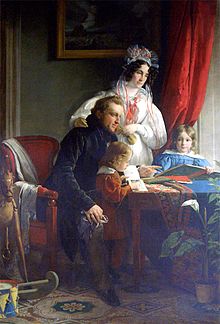August Breuner-Enckevoirt

Count August von Breuner-Enckevoirt , also Breunner-Enckevoirt , full name Count August Ferdinand Paul Ludwig Breuner-Enckevoirth, Count von Asparn, Noble Lord on Staatz, Baron on Fladnitz, Stübing, Rabenstein , (born June 30, 1796 in Regensburg ; † April 23, 1877 in Villa Weinhart, Obermais near Merano ) was an Austrian nobleman, landowner, civil servant, member of parliament and collector .
Life
Breuner came from the noble family Breuner and inherited after the death of his father Count Josef Breuner-Enkevoiert (1765-1813) his title and property, so u. a. the title of Oberst-Erblandkämmerer in Lower Austria . He was a landowner in Grafenegg , Neuaigen and Asparn an der Zaya . In Vienna he worked as a civil servant (court secretary, councilor and ministerial councilor) in the court chamber and in the ministry for regional culture and mining.
He was one of the leaders of the liberal opposition in Austria, was involved in Metternich's resignation in 1848 and, after the revolution of 1848, president of the Security Committee in Vienna. From 1861 to 1863 Breuner was a member of the House of Representatives of the Reichsrat and from 1861 to 1865 a member of the Lower Austrian state parliament as a representative of the large landowners.
From 1840 onwards, he had his seat at Schloss Grafenegg extensively rebuilt in the romantic- historical style by the architect Leopold Ernst and his son Hugo Ernst . Around 1853 he acquired the Palais Lubomirski in Vienna, which he sold again in the late 1860s; In 1869 he acquired the Palais Neupauer in Vienna, which was named Palais Breuner . In the Vienna stock market crash of 1873 he lost a large part of his fortune.
He collected u. a. Fossils . Old labels from the Imperial and Royal Geological Institute identify him as the founder of palaeontological objects. He is said to have discovered the Miocene mollusc site in Niederkreuzstetten . The lower jaw of a Deinotherium giganteum from Stettenhof near Krems was given to the Naturalien-Cabinet by him.
family
Breuner married Countess Maria Theresia Caroline Esterházy von Galántha (1802–1837) in 1827 . With their son August Johann (1828-1894), the family branch died out, as he only had daughters.
literature
- Lower Austria Landtag Directorate (Ed.): Biographical Handbook of the Lower Austrian Landtag 1861–1921 (= NÖ-Schriften. Volume 166). Lower Austria Landtag Directorate , St. Pölten 2005, ISBN 3-85006-166-3 ( PDF ).
Web links
Individual evidence
- ^ Hans Tietze : The pre-March Vienna in words and pictures . Schroll, Vienna 1925, p. 102; Lothar Höbelt : 1848. Austria and the German Revolution . Amalthea. Vienna 1998, ISBN 3-85002-413-X , p. 55.
- ↑ Announcement of the Security Committee of May 18, 1848 ( Memento of the original from November 5, 2014 in the Internet Archive ) Info: The archive link was automatically inserted and not yet checked. Please check the original and archive link according to the instructions and then remove this notice. .
- ^ Helmuth Zapfe : Index Palaeontologicorum Austriae (= Catalogus fossilium Austriae issue 15). Publishing house of the Austrian Academy of Sciences, Vienna 1971, p. 20 ( PDF; 369 kB ).
| personal data | |
|---|---|
| SURNAME | Breuner-Enckevoirt, August |
| ALTERNATIVE NAMES | Breuner-Enckevoirt, August Ferdinand Paul Ludwig Graf (full name); Breuner-Enckevoirth, August; Breunner-Enckevoirt, August; Breunner, August |
| BRIEF DESCRIPTION | Austrian nobleman, landowner, civil servant and politician, member of the state parliament |
| DATE OF BIRTH | June 30, 1796 |
| PLACE OF BIRTH | regensburg |
| DATE OF DEATH | April 23, 1877 |
| Place of death | Obermais near Merano |